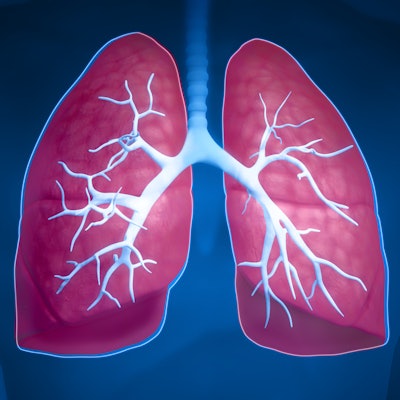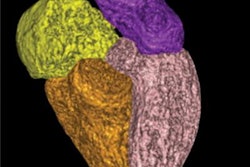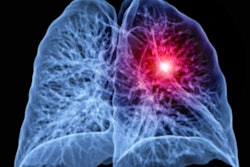
Using different types of volumetry software to measure nodules on CT lung cancer screening exams can drastically alter the recall rate for follow-up exams, underscoring the need to validate the software to ensure effective screening, according to an article recently published online in the European Journal of Radiology.
"Many European countries are deciding whether to implement lung cancer screening with CT," wrote first author Dr. Eleanor Ngan-Soo of the U.K. North Bristol National Health Service (NHS) Trust and colleagues. "A critical factor in this decision will be cost-effectiveness, and central to this is the appropriate minimization of false positives."
In an effort to reduce the number of false-positive cases, European lung cancer screening investigators established nodule management guidelines suggesting that only individuals found to have solid nodules 100 mm3 or larger on their CT scans should return for a repeat CT screening exam. The British Thoracic Society made a similar recommendation but decided on 80 mm3 as the minimum volume threshold.
For the current study, Soo and colleagues evaluated whether using a different volume threshold -- for nodules measured by seven commercially available volumetry software packages (VSPs) -- would affect CT lung screening recall rates (Eur J Radiol, September 8, 2019).
The researchers used each of the volumetry software packages to measure the volumes of 156 small-sized lung nodules (50 mm3 to 150 mm3) identified on CT scans from the U.K. Lung Cancer Screening Trial. One of the software packages (VSP 1) was used in the Dutch-Belgian Randomized Lung Cancer Screening (NELSON) trial and served as the reference standard.
Overall, there were statistically significant differences in recall rates between the reference standard and all but two of the volumetry software packages (VSP 5 and VSP 7) using the 100-mm3 threshold, the researchers found. In a similar manner, applying the 80-mm3 threshold resulted in statistically significant increases or decreases in recall rates for all but two of the software packages (VSP 2 and VSP 6), compared with the reference standard.
| Effect of different volumetry software packages on CT lung screening recall rates | ||||||
| VSP 2 | VSP 3 | VSP 4 | VSP 5 | VSP 6 | VSP 7 | |
| 100-mm3 nodule volume threshold | ||||||
| Recall rate | 12.1% | 17.7% | 94.3% | 30.1% | 10% | 23.4% |
| 80-mm3 nodule volume threshold | ||||||
| Recall rate | 26.7% | 31.5% | 99.1% | 50.4% | 19.1% | 36% |
Still, two volumetry software packages (VSP 5 and VSP 7) did end up more closely matching the performance of the software package used in the NELSON trial (VSP 1) when using 100 mm3 as the nodule volume threshold, suggesting that 100 mm3 is likely a more accurate volume threshold than 80 mm3.
These results confirm that there is a need for distinct nodule size thresholds in recalling individuals for CT lung cancer screening depending on the type of volumetry software used, the authors noted. The findings also underscore the importance of benchmarking data and the type of volumetry software applied in ongoing lung screening trials.
"For screening to be successfully implemented, clinicians need to know that the [volumetry software package] used in their screening program is comparable to those used to set guidelines," they concluded. "Further work is needed to collate standardized nodule datasets, such that all [volumetry software] can be tested for performance and consistency via formal benchmarking exercises."




















